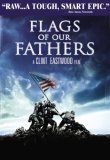Synopsis
Of all the recent multi-film director stories that have been told in recent years, not too many have been as, well, historical, as Clint Eastwood’s two part telling of the battle at the Japanese island of Iwo Jima. The battle over a key stretch of property in World War II cost thousands of lives, but never seemed to get a proper cinematic treatment as many of the European theater battles have. Regardless, in Letters From Iwo Jima and Flags of our Fathers, Eastwood has given the world …nother series of films that go beyond the normal “war is hell” mentality, and the first one has just come to DVD shelves.
Based on the book by James Bradley and Ron Powers and adapted to the screen by Paul Haggis (Million Dollar Baby) and William Broyles (Jarhead), Flags of our Fathers is material that accomplished a couple of things. It is an effective interpretation of the events on Iwo Jima which is largely based on recollection. The Marines who stormed the beach and climbed Mount Suribachi, and managed to raise a flag on top of the island became heroes, though they downplay their actions for several reasons. First and foremost was the historical reason. The flag was raised after five days of battle, yet there was another month of fighting in various methods after that, and the battle eventually ended after almost 25,000 people had died fighting. Second, the flag raising was done a couple of times, the picture that caused all the rage was for a anticlimactic (at the moment) flag raising done by John Bradley (Ryan Philippe, Crash), Ira Hayes (Adam Beach, Windtalkers), Rene Gagnon (Jesse Bradford, The West Wing), Mike Strank (Barry Pepper, Saving Private Ryan), Franklin Sousey (Joseph Cross, Running With Scissors) and Harlon Block (Benjamin Walker, Kinsey). It was publicized at the time that Hank Hansen (Paul Walker, Eight Below) was one of the raisers, but over time, that was since debunked. Half of the people in the photo did not make it off the island.
After the flagraising, the survivors were brought home and were part of a publicity campaign for American to buy war bonds, and at times the experiences were belittling, but still managed to pull through it before the group was disbanded (one was sent back to the front). After the war, the survivors went their separate ways, and in one touching (and factual moment), one of the survivors walks and hitchhikes to Texas to tell the Block family the truth about the event. Block’s mother, who had long since left her husband and believed that the backside she saw was her son’s, was vindicated. Bradley stepped off the train and married his high school sweetheart, and eventually purchased a funeral home, where he spent the rest of his days.
The film very easily could have been one of those films that looked at the war, and the aftermath of it, but what Eastwood does is intersperse flashbacks that are the war scenes (which, by the way, look pretty good. They really convey the scale of the battle, from troops to artillery to aircraft) with the publicity tour that the survivors did. They tell each other and anyone who’ll listen that what they did was no big deal. They firmly believe that, as the flag raisings prove. But what they’ve experienced together, what they could never forget, are things that they dare not speak of for the rest of their lives. Upon further examination in the book, you get how good of an idea Bradley’s reluctance to talk is, even four decades after the event.
If there’s anything that hinders the film experience, it’s the flashbacks, ironically enough. With Haggis’ and Broyles’ script, it would have been a far more effective telling if it were done chronologically, which it almost seems to lose in the film. But Flags of our Fathers really gives you a good idea of how the home front was, while not completely losing the picture of just how gruesome it is. Having just seen Letters From Iwo Jima and experiencing the completeness of Eastwood’s tale, veterans of the Pacific war theater on both sides of the fence should feel that the story is just and their service appreciated.
Video
Like other recent Eastwood films, this one is shot in 2.35:1 anamorphic widescreen, and possesses a lot of the blacks and slightly blown out whites a la Million Dollar Baby, or to a lesser extent, Mystic River. Still, when the colors come out, they look fairly vibrant without any real bleed. It’s not my personal choice for color style, but war isn’t that glamorous.
Audio
Dolby Digital 5.1 Surround. The battle scenes are solid and sport a lot of surround activity behind and around them, but the overall sound mix is just a bit on the erratic side. The dialogue is very soft, and almost non-existent when it comes to the Times Square scene. Before I forget, the battle scenes possess far more low end activity with a battleship gun firing or mortar attack, more than I recall experiencing in other films. I wouldn’t go so far as to say it’s a reference track, but it’s damn good nonetheless.
Special Features
Zip. Not even a scene selection option on the disc menu. Of course, since Letters From Iwo Jima just came out in wide release at the time of this review, I sense a double-dip is on the horizon.
Closing Thoughts
Flags of our Fathers is by far the best film told about events in the war with Japan that had nothing to do with Pearl Harbor. Even without seeing the other Eastwood film, I would easily encourage everyone to rent and see it. I can’t give it a full-blown buy recommendation because I think the jury’s still out, but it’s definitely worth adding to your Netflix queue ASAFP.





